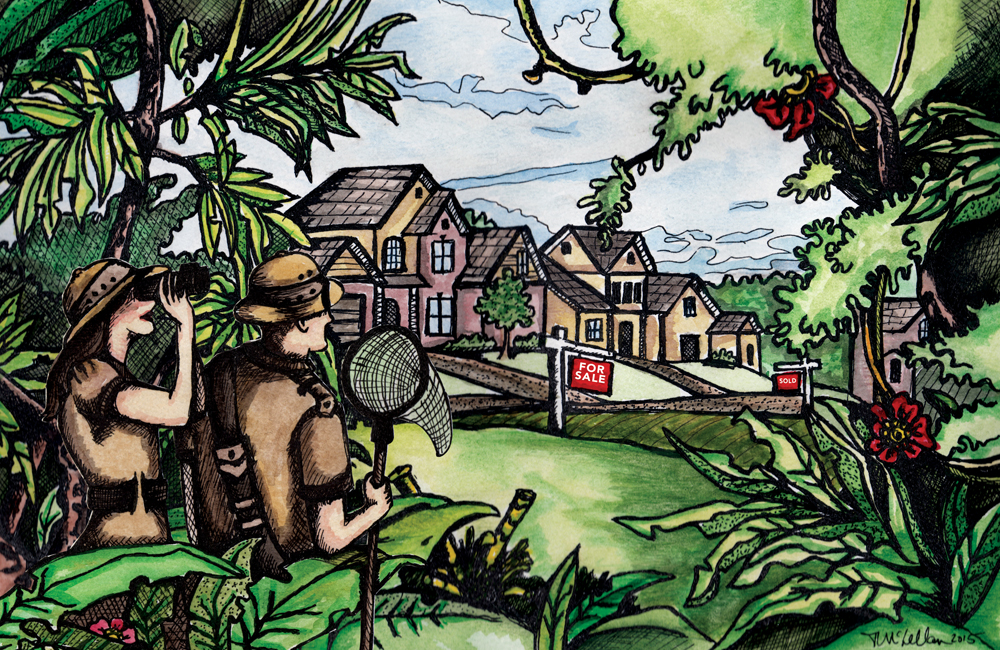After a wild ride in 2016 and 2017 and a cooler market in 2018, local real estate experts are forecasting a more balanced scenario for 2019, with some areas possibly tipping over into a buyer’s market
by Marc Huminilowycz
illustration by Shelagh Armstrong-Hodgson

Has the bubble finally burst? Have we reached a tipping point between a seller’s and a buyer’s market? Following a couple of years of multiple offers, bidding wars and record-breaking home prices in Southern Georgian Bay, we appear to be headed for what realtors call a “balanced market,” with some areas starting to show signs of tipping over into a buyer’s market.
Real estate sales through the end of February increased 29 per cent in terms of unit sales over February of 2018, with year-to-date sales up 4.2 per cent over the first two months of last year, according to the Southern Georgian Bay Association of Realtors (SGBAR). In dollar volume, sales were up 21 per cent over the same period last year but remain 11 per cent below the first two months of 2018.
“Home sales posted some decent year-over-year gains in February, although that was really just the flipside of last year’s very quiet month of February, which you’ll recall was the weakest month for sales in the region in more than five years,” said Stan Reljic, president of the SGBAR. “Having said that, inventories across the region remain near historic lows, which continues to lend support to prices even with demand still running at below-average levels.”
Sales to new listings – the ratio between the number of homes sold and the number of new listings on the market – were at 45 per cent in early 2019 compared to 61 per cent in January 2018. A lower ratio means a more balanced market, and lower still would put our area in buyer’s market territory.
There have been some definite shifts since this time last year. Many realtors interviewed for On The Bay’s annual real estate report last spring predicted that 2018 would be a year much the same as 2017, but the market was softer than expected, with the number of home sales down about 18 per cent, total sales volume down 14 per cent and sales to listings down 10 per cent from the previous year.
It is important to note three important factors which affected real estate here and in the rest of Ontario in 2018: three increases in the Bank of Canada interest rate; mortgage stress test rules which came into effect on January 1; the province’s Fair Housing Plan, introduced in 2017 to quiet the market frenzy; and a lack of housing supply driving prices up.
On a more positive note, sales volume and average home sale prices in Southern Georgian Bay were up in the last quarter of 2018. In January of this year, the average home sale price was up almost 30 per cent and the number of new listings rose 13 per cent in our region compared to January 2018. And most economists predict that interest rates are unlikely to climb significantly this year. So, what does this all mean for real estate activity in 2019?
On The Bay reached out to the region’s real estate professionals to find out what is going on.
Stan Reljic, SGBAR president, said he believes the softer market in 2018 was the result of two primary factors: historical low supply of homes and separate government intervention measures designed to cool down the hot real estate market and make it more challenging for some buyers to secure mortgages.
“It’s frustrating,” he said. “Those measures were geared to the GTA and Vancouver but they painted the entire country with the same brush. It’s not fair to Southern Georgian Bay or other regions across Canada.”
He added the real estate market in our region, while still struggling with supply, is becoming more balanced. Looking at SGBAR statistics for 2018 and January 2019, he noted that, while the $1-million-plus segment has held strong, the $300,000 to $500,000 category remained the biggest challenge. “This segment was down in 2018 from 2017 mainly because of the large volume of sales in the last quarter of 2017, when people were jumping the new mortgage rules that came into effect on January 1st.”
For January figures, Reljic acknowledged that more sales of homes valued at $1.5 million up-skewed the increase in the average home sale price over the year before. “January was spectacular in the higher-priced segment. The skiing was great, the roads were good and a lot of people came up eager to buy,” he said, noting that minor drops in the other price categories were due to traditionally slower sales in December and January.
Reljic added he is optimistic about real estate in Southern Georgian Bay in the year to come. “The numbers were down in 2018, but we had the third highest dollar sales volume ever.” Like other realtors, he is encouraged by the increase in home inventory of 20 per cent year-to-date in the last quarter of 2018.
“Based on what we’re seeing, our market is still strong,” he observed. “The GTA market, with home prices predicted to rise by four per cent in 2019, is still robust. What Toronto people buy here will directly depend on what they get when they sell there. Three to four years ago, when there was lots of inventory here, GTA buyers were selling high and moving. Now, with our prices going up and a more stable market there, retiring boomers who have made their wealth are looking for the lifestyle that we have to offer. I’ve always said that a softer GTA market will prompt them to say, ‘It’s over. Let’s sell. What are we waiting for?’ ”
In addition to Reljic, On The Bay interviewed six prominent realtors from across the region to ask them about their sales experiences in 2018 and early 2019, what buyers and sellers need to know and do in the current balanced market, the influence of the GTA market in our region, and their real estate predictions for 2019 and beyond.
Realtor Observations
“The Wasaga Beach real estate market has grown phenomenally over the past 10 years,” said Jason Ruttan of ReMax of Wasaga Beach. “The latest statistics from January show the average price of a (freehold) detached home at $465,193. In January 2009, it was at $253,689. That’s a $211,000 increase.”
Ruttan noted a consistently high sales-to-listings ratio (approximately 97 per cent) over the past two years in Wasaga Beach and Collingwood. “In 2016, we had a busy year,” he said. “In 2017, with low inventory and high sales volume, we saw 20 per cent of transactions carrying forward into 2018, resulting in a decrease of 33.8 per cent in sales of detached homes from the previous year. We’re coming off two years of busy sales with not enough homes to sell, mainly because nobody wants to move again.” Ruttan added he is encouraged by January sales volume numbers, which show a difference of only three sales less than the previous January. “Last year was a slower market here, but there’s a lot of interest in our area from across Ontario.”
Cheryl Morrison of Royal LePage Trinity Realty in Stayner said she is buoyed by the opportunities a more balanced market presents. “I quite like the market now,” she said. “The frenzy a year ago left me shaking my head, asking ‘why?’ We have so many options now, with so many market niches. It’s a healthier environment for buyers and sellers, and the new mortgage rules have brought a sensibility to the real estate market.”
She added the current market continues to grow in dollar value, with a population that continues to move for a variety of reasons, including downsizing or upsizing according to family changes. “The state of the economy really doesn’t matter,” Morrison adds. “The frenzy is gone. Now, we have time to think, analyze and find what’s best for us and our families.”
According to broker Kevin Gilchrist of Sotheby’s International Realty Canada, the phenomenal rate of growth experienced in Southern Georgian Bay over the past few years could only last for so long. “I’m feeling good about it. January was great, but inventory is low,” he said, noting increases in average sale prices in both The Blue Mountains and Collingwood, but with a sharp downward trend in sales-to-listing ratio (32.7 per cent) in Collingwood compared to January 2018. “Collingwood is approaching a balanced sellers’/buyers’ market. The biggest challenge here is buyers qualifying for a home purchase according to the mortgage stress test rules,” said Gilchrist.
“There is hardly any inventory in the luxury home market, but I had a $2 million sale in January – a Toronto professional couple in their late 40s purchasing their second or third home. The luxury and low-end markets are doing great. It’s the $700,000 to $800,000 category that’s tough now. I think the market will reveal what’s happening this spring.”
Barb and Ron Picot of Chestnut Park Real Estate in Collingwood concur with Gilchrest, although they experienced a January with unit sales down (compared to a year before), which they attribute to a combination of the market and several cancelled showings due to poor weather and road conditions.
“Most buyers now are cautious. They’re taking their time,” said Barb Picot. “And financing is coming into play, with deals falling apart because buyers fail to get the money they’re looking for. This applies all across the board, even for buyers of $1-million-plus homes.”
Like other realtors in the region, the Picots are encouraged by early 2019 real estate figures, which show increases in both the number of new listings and active listings in the region compared to the year before.
“There’s a strong demand for housing in the current market,” said Ron Picot. “Overall, we continue to experience it from four market segments: weekend and vacation home buyers; retired and semi-retired couples and individuals; and 30 to 50-year-old work-from-anywhere families. These buyers tend to be all from the GTA and the Golden Horseshoe. As well, we have buyers from all demographics already in the area, moving up or down the value scale according to their needs at this point in time.”
Broker Christine Smith of Royal LePage Locations North said she hasn’t noticed a levelling off in the market. “I don’t really look at the numbers. I’m busy all the time. The market hasn’t levelled off for me. I had four transactions go through in January when I managed to squeeze in a short holiday. I don’t see any downward trend.”
Jean Boynton, broker of record with ReMax High Country Realty, has been specializing in “country lifestyle” real estate in the Beaver Valley, Grey Highlands and Flesherton areas and beyond since 1994. “It’s a different climate now than it was 10 years ago,” she observed. “Inventory is extremely low, and I wouldn’t say the market in 2018 and early 2019 was ‘hot, hot, hot’ as it was a couple of years ago when the economy was better. The good news is that the market here is strong, with January figures almost the same as they were the year before.”
In her market area, Boynton said home prices were “pretty much the same” over the past few years, while listings appear to be moving in the right direction. “Two years ago, I couldn’t find anything for buyers. Now, we can find listings for them, but it might take a little longer.”
Buyer & Seller Challenges
“Buyers, sellers and realtors need to acknowledge the changes happening in our market,” said Jason Ruttan. “Realtors need to understand the buying consumer and prep their sellers. Where are buyers looking? What do they expect? Traditional methods of selling are just not relevant anymore.”
According to Cheryl Morrison, buyers always need to educate themselves and be more cognizant of the market at any given time. “The buyers are there. They’re sophisticated. They’ve done their homework.” Nevertheless, the new mortgage stress test rules are putting more pressure on buyers, said Kevin Gilchrist of Sotheby’s International Realty. “In the past two years, buyers haven’t needed to do a lot,” he said. “Now, in a more competitive environment, they need to do more in order to be competitive.”
The biggest challenge for buyers in the current market, according to Barb and Ron Picot, is finding the right homes in the right locations to match their needs. “The biggest challenge for sellers is having a good understanding of what their properties are actually worth,” said Barb. “This is where realtors are valuable. They can put each property in the right perspective, in view of what similar properties are selling for.”
Ron gave the example of one set of sellers who wanted to price their home high. “We encouraged them to set a more realistic price even though their friends were telling them that their home is worth more. The drop in price was painful, but it helped them sell their home.” He noted that while waterfront land in the region is increasing in value significantly due to a noticeable scarcity, “Even these properties may sit on the market for extended periods of time if list prices are too high.”
Jean Boynton agreed. “When you’re selling a $1-million-plus rural property, you need to find someone who will market it properly to Toronto clients who are looking for acreage,” she said. “The biggest challenge for sellers is having a realistic idea of price. They know it’s a hot market, and they want to ask for more. I have a client now who has had numerous showings, but no offer they were willing to accept. That indicates that something isn’t right. They’re pricing their property too high.”
According to Christine Smith, the largest challenge to buyers is the lack of inventory, primarily because homes in our region are listed year-round. For sellers, she recommends that their home be move-in ready. “Paint and clean up,” she said. “Buyers here are looking for a weekend home with no renos, so you need to give them the biggest bang for their buck.”
The GTA Factor
“Typically, Southern Georgian Bay follows the GTA,” said Barb Picot. “However, even with real estate costs moderating somewhat there, prices are still quite robust, which encourages boomers to cash out and move to quality lower cost areas like ours, as well as work-from-anywhere families who are attracted to the lifestyle here.” Considering these points, she believes that any softening in the GTA will probably have a moderate impact in our region. Jean Boynton concurs, saying, “From my experience, our market follows the GTA, but it happens a bit later. If the real estate market drops there, it may be just a little harder for people to sell their homes.”
However, Christine Smith said she sees less of a GTA influence on our market. “I’m not worried about the GTA,” she said. “Regardless of the impact of the global market, the mortgage stress test or interest rates, real estate activity won’t slow down here if it slows down there. Retirees and people in their thirties with kids are selling their properties and coming here. Most of these buyers don’t need mortgages.”
Predictions: 2019 and Beyond
The Canadian Real Estate Association (CREA) predicts a slight rise in the national average home price in Canada of 1.7 per cent in 2019, but an increase of 3.3 per cent in Ontario, which will help to restore confidence in the real estate market, according to Jason Ruttan. “Consumers are more inclined to purchase now, but some Ontario markets are moving too quickly,” he said. “Toronto buyers and sellers are waiting and looking for a safe place to invest.”
Ruttan added that sellers in Southern Georgian Bay should consider themselves fortunate. “There’s a lot of interest in our area from across Ontario. Even though last year was a slower market here, there’s still great demand,” he said. “Our market was undervalued for many years. In 2016/2017, we moved up with everyone else, and didn’t slow down.”
He said the moderate increases our area has experienced denote a healthy market. “Real estate in our region is still good value,” said Ruttan. “Wasaga Beach has shown consistent growth. There are 5,000 homes in the town’s Active Development Plan. There’s a lot of room for future growth.”
Barb and Ron Picot agree that the demand for housing in Southern Georgian Bay will remain strong in the years ahead, with the GTA and the Golden Horseshoe continuing to grow on an ongoing basis – unless the Ontario and Canadian economies have a major downturn. “The GTA currently has a population of 6.4 million, and 9.3 million live in the Golden Horseshoe,” observed Ron. “By 2041, the populations of the GTA and the Golden Horseshoe are projected to grow to 9.7 million and 13.5 million respectively. The continued growth in these areas to the south of us will lead to growth in our area because of our close proximity to them, and the quality of life we have to offer. Because of this, Southern
Georgian Bay real estate is bound to get more expensive. We can’t build fast enough, and there’s not enough product, space or infrastructure to satisfy the demand.”
For 2019, Kevin Gilchrist predicts a market “somewhere between balanced and sellers,” with the entry-level segment continuing to be brisk.
Because we have so many market niches in Southern Georgian Bay, it’s a healthy real estate environment with lots of resiliency, said Cheryl Morrison. “A softening of the market could start to skew everything else, affecting certain niches and price points. But our area is unique, with so many buyers looking for so many different things, whether it’s young families coming to our affordable subdivisions or retirees planning activities for their future. To all of them, owning a home is important. This is a critical component of who we are.”
In a phrase, Morrison describes Southern Georgian Bay’s real estate outlook for 2019 and beyond as positive and healthy, noting that our region is “not Sleepy Hollow anymore.”
A trend towards a healthy, balanced market, continued demand from educated buyers in the GTA, realtor optimism with positive January sales figures, setting more “realistic” pricing of properties – following a period of frenzied real estate activity, a new reality has set into Southern Georgian Bay. How will 2019 and beyond shape up? This spring will tell. ❧
The Economists Weigh In
According to most realtors in Southern Georgian Bay, there is no question that real estate activity here is directly affected by what happens in the GTA. A recent market report from the Ontario Home Builders’ Association quoted three prominent economists – two from major banks and one from the CMHC (Canada Mortgage and Housing Corporation) – with their predictions for the Ontario real estate market in 2019.
The consensus was that, while demand versus affordability continue to play out in the GTA, with modest gains in sales and prices and more housing choice, regions in Ontario outside of the GTA will see the most impressive real estate strength. Why? The economists point to two demographics: early retirees in Toronto, looking 100 kilometres away where prices of homes are half the cost, and cashing in their chips if it makes sense; and a hot Toronto market that has been pushing away younger buyers looking for affordable homes.
According to the economists, Ontario’s housing market saw dampened activity in 2018, as was the case in our region. They predict that existing home sales and starts in the province will post a partial recovery in 2019. Buyers will re-enter the market on the strength of stronger than expected job growth and immigration numbers before a downward trend in starts and sales resumes in 2020.
Inna Breidburg, a senior economics analyst at the CMHC, offered some insights into the near future of real estate in Southern Georgian Bay. “Demand for housing here is impacted by multiple factors such as consumer confidence, interest rates, incomes and demographic trends,” she said. “Over the past 15 years, sales activity (resale) in the region has been relatively stable, except for a spike in 2016-2017. Given underlying economic and demographic fundamentals, sales here are likely to settle around the long-term historical average.”
Breidburg attributes the decline in listings here to a trend of fewer people moving out of the region and more seniors deciding to age in place. “In 10 years, we have seen a shift in new home construction to multi-family housing, with more apartments beginning recently,” she said, noting the latest (2016) census data showing about 75 per cent of private dwellings in our region occupied by permanent residents – lower compared to nearby communities like Barrie, but increased since the previous census.
“This suggests that a growing share of residents stay in the region permanently or move in to live here. More multi-family homes are being built and, with more seniors staying in the region, the share of residents living in single detached homes has decreased over the past 10 years,” said Breidburg. “In 2018, listings seemed to stabilize, with relatively minor decline compared to 2017. I sense that there won’t be significant changes this year.”
In summary, she predicts that price growth in the GTA will resume in 2019 to mirror the general rate of inflation, with a similar trend occurring in Southern Georgian Bay.













